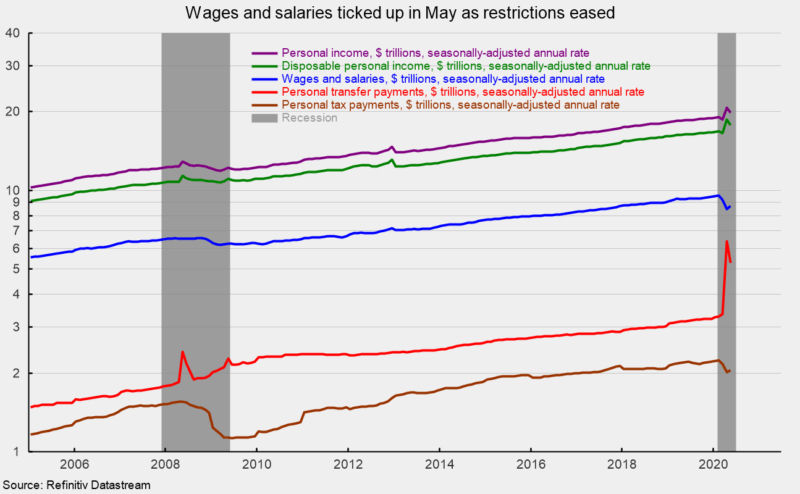Easing Restrictions Helped Boost Wages in May
Personal income fell 4.2 percent in May, according to data from the Bureau of Economic Analysis. Personal income data over the past few months have been sharply distorted by lockdown policies which caused massive layoffs and government stimulus programs that sent transfer payments skyrocketing (see first chart).
The drop in personal income consisted, in part, of a 2.7 percent increase in wages and salaries. Wages and salaries, which typically account for about half of personal income, rose as some employees went back to work after lockdown policies were eased. Supplements to wages and salaries (primarily employer contributions to pension and insurance funds and government social-insurance programs) which typically account for another 12 percent of personal income also posted a gain, rising 1.2 percent in May.
Proprietors’ income jumped 2.8 percent for the month following a 12.7 percent plunge in April while income on assets (interest and dividends) dropped 1.4 percent in the latest month.
Personal transfer payments fell 17.2 percent in May after a massive 90.1 percent gain in April. Personal tax payments rose 1.8 percent, leaving disposable income with a drop of 4.9 percent (see first chart). Adjusting for price changes, real disposable income fell 5.0 percent in May, down from a 13.6 percent rise in April.
On the spending side, total personal consumption expenditures (PCE) rose a record 8.2 percent in May following a 12.6 percent decrease in April. Among the components, durable goods rose 28.6 percent while nondurable-goods spending gained 7.7 percent and spending on services increased 5.4 percent for the month (see top of second chart). After adjusting for price changes, real PCE increased 8.1 percent with a 28.4 percent gain in real durable-goods spending, a 7.9 percent gain in real nondurable-goods spending and a 5.2 percent rise in real services spending. Despite the gains in May, spending is still down from a year ago in nominal terms with total expenditures off 9.3 percent, durable-goods spending down 0.3 percent, nondurable goods down 2.4 percent, and services showing a 12.7 percent drop (see bottom of second chart).
The personal savings rate held at an extremely elevated level in May, coming in at 23.2 percent of disposable income following rates of 32.2 percent in April, and 12.6 percent in March. A more comprehensive measure of savings is available in the quarterly flow-of-funds data from the Federal Reserve. That measure has typically shown a higher savings rate compared to the measure in the monthly personal-income release.
The price indexes from the report on personal income and spending are the primary measures followed by the Federal Reserve. The total PCE price index increased 0.1 percent in May as durable-goods prices rose 0.2 percent, nondurable-goods prices fell 0.1 percent, and services prices increased 0.2 percent. The PCE price index excluding food and energy rose 0.1 percent for the month.
Over the past year, the PCE price index is up 0.5 percent, down from the 0.6 percent in the prior month. The core PCE index, which excludes food and energy prices, is up 1.0 percent from a year ago. That measure has been running at or below 2 percent since 2012.
Economic activity remains extremely distorted following the outbreak of COVID-19 and the implementation of lockdown policies to reduce the spread of the virus. As some restrictions are eased, signs of a rebound in activity are emerging. However, massive damage has been done to the economy. Ultimately it will be the progression of the virus, the success of efforts to eradicate it, and polices implemented to deal with it that will determine the path of economic recovery.







